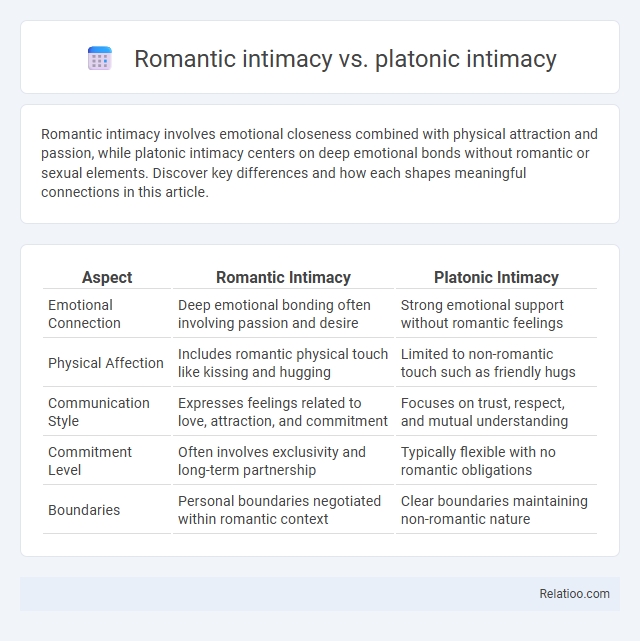Romantic intimacy involves emotional closeness combined with physical attraction and passion, while platonic intimacy centers on deep emotional bonds without romantic or sexual elements. Discover key differences and how each shapes meaningful connections in this article.
Table of Comparison
| Aspect | Romantic Intimacy | Platonic Intimacy |
|---|---|---|
| Emotional Connection | Deep emotional bonding often involving passion and desire | Strong emotional support without romantic feelings |
| Physical Affection | Includes romantic physical touch like kissing and hugging | Limited to non-romantic touch such as friendly hugs |
| Communication Style | Expresses feelings related to love, attraction, and commitment | Focuses on trust, respect, and mutual understanding |
| Commitment Level | Often involves exclusivity and long-term partnership | Typically flexible with no romantic obligations |
| Boundaries | Personal boundaries negotiated within romantic context | Clear boundaries maintaining non-romantic nature |
Introduction to Romantic and Platonic Intimacy
Romantic intimacy involves emotional closeness characterized by passion, physical affection, and a desire for a romantic connection, often including elements such as trust, vulnerability, and mutual attraction. Platonic intimacy centers on deep emotional bonds without romantic or sexual elements, emphasizing friendship, shared interests, and mutual support. Understanding the distinctions helps you navigate your relationships and foster meaningful connections suited to your emotional needs.
Defining Romantic Intimacy: Key Characteristics
Romantic intimacy involves deep emotional connection and physical attraction, characterized by passion, desire, and a commitment to a romantic partner. Unlike platonic intimacy, which centers on friendship and emotional closeness without sexual involvement, romantic intimacy blends affection with exclusivity and shared life goals. Understanding these key traits helps you differentiate the type of bond you experience and fosters deeper emotional fulfillment.
Understanding Platonic Intimacy: Core Elements
Understanding platonic intimacy involves recognizing emotional closeness and trust without romantic or sexual involvement, emphasizing deep friendship bonds and mutual support. Unlike romantic intimacy, which often integrates physical affection and passion, platonic intimacy centers on open communication, shared values, and consistent presence. Cultivating this form of intimacy enhances mental well-being by providing reliable companionship and unconditional acceptance.
Emotional Connection: Romantic vs Platonic Intimacy
Romantic intimacy involves a profound emotional connection characterized by passion, desire, and a unique bond that often includes physical affection and exclusivity. Platonic intimacy, on the other hand, centers on deep emotional trust, understanding, and support without romantic or sexual elements, fostering meaningful friendships and non-romantic relationships. Understanding the nuances of your emotional connections can help you navigate the distinct dynamics between romantic and platonic intimacy, enhancing your relationships' depth and authenticity.
Physical Expressions: What Differentiates Each?
Romantic intimacy involves physical expressions such as passionate kissing, hugging, and sexual touch that convey love and desire beyond friendship. Platonic intimacy is characterized by non-sexual physical expressions like casual hugs, hand-holding, or comforting touches that emphasize emotional support and trust. Your understanding of intimacy deepens when recognizing that physical expressions vary widely depending on the relationship's emotional context and boundaries.
Boundaries in Romantic and Platonic Relationships
Romantic intimacy involves deeper emotional and physical connections, often requiring flexible boundaries to foster trust and vulnerability, while platonic intimacy centers on emotional closeness without sexual elements, emphasizing clear boundaries to maintain mutual respect and comfort. Your ability to communicate and respect these boundaries directly impacts the health and sustainability of both romantic and platonic relationships. Understanding and honoring the distinct needs and limits in each type of intimacy ensures balanced connections and personal well-being.
Communication Styles: Romantic and Platonic Dynamics
Romantic intimacy involves open emotional expression, vulnerability, and physical closeness, fostering a deep connection through affectionate communication and shared experiences. Platonic intimacy relies on trust, mutual support, and intellectual exchange, emphasizing empathetic listening and non-romantic bonding without physical intimacy. Effective communication in both dynamics requires active listening, honesty, and respect, but romantic intimacy often includes more passionate and affectionate language, while platonic intimacy focuses on companionship and emotional safety.
The Role of Trust in Both Intimacies
Trust forms the foundation of both romantic and platonic intimacy by creating a safe space for vulnerability and emotional openness. In romantic intimacy, trust deepens physical and emotional connection, enhancing mutual understanding and commitment, while in platonic intimacy, it supports honest communication and unwavering support without romantic expectations. Your ability to cultivate trust directly influences the quality and depth of all intimate relationships, fostering stronger bonds and lasting connections.
Social Perceptions and Cultural Influences
Romantic intimacy often involves emotional and physical closeness with expectations of exclusivity, shaped by cultural narratives around love and partnership, while platonic intimacy emphasizes deep, non-sexual connections that challenge traditional norms of closeness and gender roles. Social perceptions frequently prioritize romantic intimacy as the ultimate form of connection, influenced by media and cultural practices that valorize romantic relationships over friendships. Cultural influences vary widely, with some societies promoting communal bonds and platonic intimacy equally or more than romantic ties, affecting how intimacy is expressed and valued across different social contexts.
Navigating Transitions Between Platonic and Romantic Intimacy
Navigating transitions between platonic and romantic intimacy requires understanding the distinct emotional layers that define each type of connection, with platonic intimacy often centered on deep friendship and trust, while romantic intimacy involves passion and physical closeness. Recognizing shifts in communication patterns, emotional vulnerability, and personal boundaries is crucial for maintaining respect and clarity as your relationship evolves. Your ability to openly discuss feelings and expectations ensures smoother transitions and strengthens the bond regardless of its nature.

Infographic: Romantic intimacy vs Platonic intimacy
 relatioo.com
relatioo.com